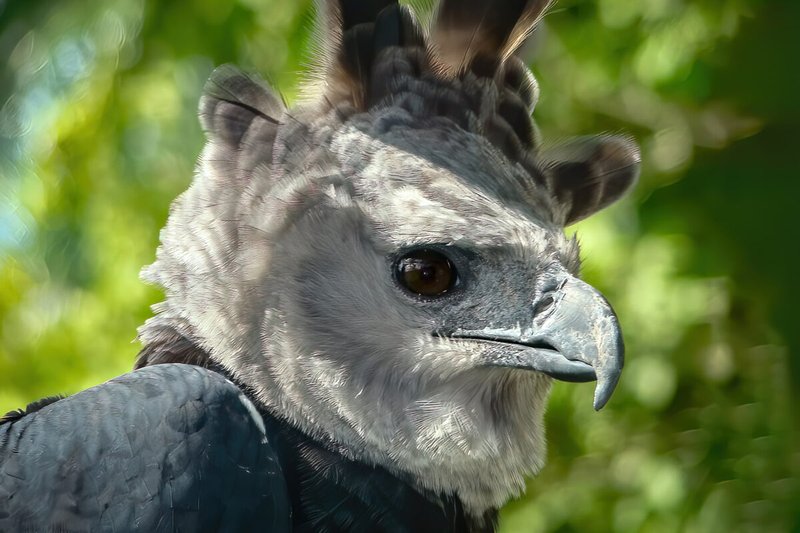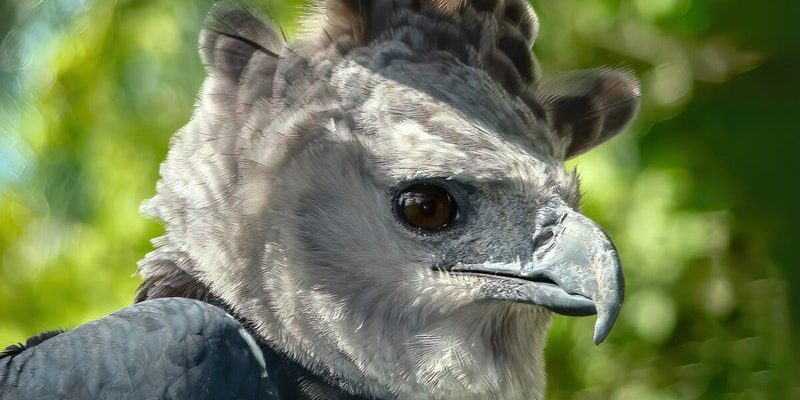
The Harpy Eagle, scientifically known as *Harpagornis harpyja*, has roots that stretch deep into the jungles of Central and South America. It thrives in the canopy layer of tropical forests, where it finds its prey and builds its nests. As we unwind this tale, you’ll discover not only how this eagle has adapted to its environment but also how it has come to symbolize strength and resilience in various cultures.
What is the Harpy Eagle?
The Harpy Eagle is truly a bird of wonder. Known for its size, it can weigh up to 10 kilograms (about 22 pounds) and measure around 1 meter (3.3 feet) in length from beak to tail. Just picture this: wings that span nearly 2.2 meters (7.2 feet) wide! That’s roughly the same width as a small car. It has sharp talons that can be over 10 centimeters (4 inches) long, making it one of the most powerful raptors in the world.
Here’s the thing—these eagles aren’t just about brute strength. They’re also incredibly intelligent. They’ve evolved to be highly skilled hunters, relying on their exceptional eyesight to spot prey from high up in the trees. Their diet mainly consists of medium-sized mammals and birds, such as monkeys, sloths, and various rodents. So, when you see a Harpy Eagle in action, you’re witnessing a master at work in its natural habitat.
The Evolutionary Journey of the Harpy Eagle
The evolutionary history of the Harpy Eagle is a tale of adaptation and survival. The ancestors of modern eagles have been around for millions of years, but the Harpy Eagle’s specific lineage diverged from other birds of prey about 20 million years ago. This long history has shaped its unique traits, such as its massive size and powerful talons.
Over time, these eagles have become perfectly suited to life in the treetops. Their adaptations include strong legs for perching and hunting, as well as a keen sense of hearing and vision—essential for spotting prey hidden among the leaves. Honestly, the Harpy Eagle is a classic example of how evolution works. It’s all about finding the right traits that help a species thrive in its environment.
Interestingly, the Harpy Eagle is part of a broader group known as the Accipitridae family, which includes other eagles, hawks, and kites. This family tree shows us the diversity and adaptability of birds of prey across different environments. Each species, including the Harpy, has carved its niche in the animal kingdom, showcasing the beauty of evolution.
Habitat and Distribution
The Harpy Eagle is mainly found in the tropical rainforests of Central and South America. Its range extends from southern Mexico, throughout Central America, and down to the northern parts of South America, including countries like Colombia and Brazil. These birds prefer dense forests, where they can easily navigate the trees and find ample food sources.
Let me explain why their habitat is so vital. Rainforests provide a rich ecosystem where the Harpy Eagle can hunt effectively. Not only do the trees offer places to nest, but they also harbor a variety of prey. This connection with the environment is crucial; without healthy rainforests, the Harpy Eagle’s population could dwindle, threatening its existence.
However, habitat loss due to deforestation poses a significant risk to these magnificent birds. As forests are cleared for agriculture or urban development, the Harpy Eagle finds it increasingly challenging to find food and suitable nesting sites. Conservation efforts are essential to protect both the eagle and its rainforest home.
Cultural Significance of the Harpy Eagle
Beyond its biological importance, the Harpy Eagle holds a special place in various cultures. In some Indigenous cultures of Central and South America, this eagle is considered a symbol of power, strength, and freedom. Many believe it embodies the spirit of the forest. It’s not uncommon to see its image represented in art, mythology, and folklore.
For example, in some Indigenous groups, the Harpy Eagle is viewed as a guardian of the forest, reflecting the deep respect these communities have for nature. Rituals and stories are often centered around this majestic bird, highlighting its role in the ecosystem and the connection between humans and the natural world. These cultural narratives help keep the eagle’s legacy alive, fostering a sense of stewardship for the environment.
Honestly, this cultural significance amplifies the need for conservation. When a species is woven into the fabric of a culture, protecting it becomes a shared responsibility. The Harpy Eagle’s story is not just about wildlife; it’s about human connection to nature.
Conservation Status and Efforts
Today, the Harpy Eagle is classified as near threatened on the IUCN Red List. This status is a wake-up call that highlights the ongoing challenges these incredible birds face. Deforestation, hunting, and habitat fragmentation are significant threats to their survival. As forests disappear, so too do the nesting sites and food sources essential for the Harpy Eagle’s life cycle.
Conservation efforts are underway to protect this species and its habitat. Organizations are working to restore rainforests, enforce legal protections, and raise awareness about the Harpy Eagle’s plight. Community engagement plays a crucial role in these efforts. By educating local populations about the importance of preserving this eagle and its ecosystem, we can foster a culture of conservation that benefits both wildlife and people.
Programs focused on habitat restoration and monitoring can help ensure the Harpy Eagle continues to soar through the skies. These initiatives remind us that wildlife conservation is not just about saving animals; it’s about preserving the intricate web of life that supports us all.
Final Thoughts
The Harpy Eagle is more than just a bird; it’s a symbol of strength, a testament to the wonders of evolution, and a critical player in the ecosystem. Understanding its history and the challenges it faces can help us appreciate the rich tapestry of life on Earth. It’s a reminder of our responsibility to protect these magnificent creatures and their habitats.
As we continue to learn about the Harpy Eagle and other species, let’s strive to create a world where they can thrive. Every effort counts, whether it’s supporting conservation initiatives or simply sharing knowledge. After all, when we nurture the environment, we’re also nurturing our own future.

